The Stories Behind
The Islands in the Stream
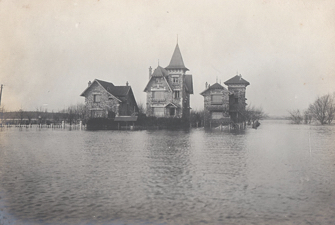
Houses on the Île de Migneaux during the Great Flood of 1910. © Cliché Gaillard/Coll. Olivier Delas/Cercle d’Études Historiques et Archéologiques de Poissy
“Îles de la Seine” at the Pavillon de l’Arsenal has a great subject but is one of those exhibitions for which you’d rather buy the book and read it in the comfort of your own home than try to absorb lots of texts and squint at small photos tacked to big white walls. And that is exactly what I did, but not before first exploring the show with the help of the champagne supplied at the opening and my friend Helen, who happens to be a landscape architect and has shared her expertise in articles on Paris Update. The champagne made it seem less like a chore to read all those wall texts and Helen helped me make sense of it.
My first piece of advice is to take the stairway on the left to reach the upstairs exhibition. The first thing you see is the beautiful meters-long schematic drawing of the islands in the Seine. After surprising you by showing how many there are, it will help you situate the location of each island.
There is something inherently romantic about islands that is only enhanced by the often-poetic names of those in the Seine. The Île des Cygnes, for example, was called the Île Maquerelle until 40 swans sent by the Danish
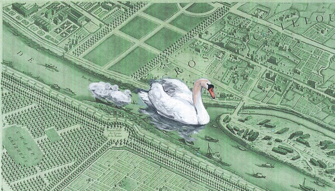
A drawing of the Île des Cygnes by Axel Wilhite. Paris, December 2015
ambassador to Louis XIV were given a home there; this island is also the site of the mass burial of the Protestant victims of the Bartholomew’s Day massacre in 1572.
The Île des Impressionistes, or Île de Chatou,
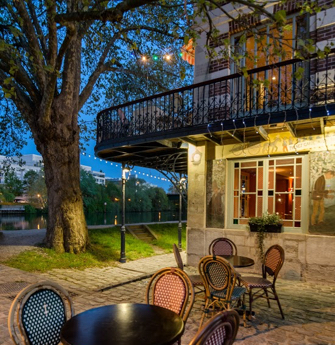
Île des Impressionnistes. © Pierre L’Excellent, 2016
was a popular meeting place for painters and canoeing aficionados, including Caillebotte, Monet and Renoir.
The name of the Île Olive comes not from olive orchards but from the family who left it to the city of Nogent on condition that it be named after them and that it be left as it was, a commerce-free park open to the public.
The Île des Dames (Ladies’ Island) was where women met to hear the proclamation of new laws during the French Revolution and was originally an archipelago with the even more evocative name “L’Enfer, le Purgatoire et le Paradis” (Hell, Purgatory and Heaven).
From an article by Jacques Damade in the eponymous book that accompanies the exhibition, I learned that in the 16th century, Paris had a dozen or more islands in the Seine – a “rosary” or archipelago of them – but only around five bridges, none of which crossed the river entirely, connecting only with the islands.
Today Paris has only three islands: the Île de la Cité, the Île Saint Louis and the Île aux Cygnes. The latter, where a miniature Statue of Liberty raises her beacon at one end, is actually an artificial island that has no relation to the above-mentioned Île des Cygnes, which is now incorporated into Paris’s Champ de Mars.
The Île de la Cité, the historic heart of the city and now the largest island, was once three separate islands. When the Pont Neuf – the first bridge to connect Left and Right Bank – was built, the Île à la Gourdaine and Île aux Juifs were merged with the Île de la Cité, creating the Place Dauphine and the Square du Vert Galant.
Every island has its story. Who knew, for example, that there used to be a nudist/health colony called “Physiopolis” on the Île du
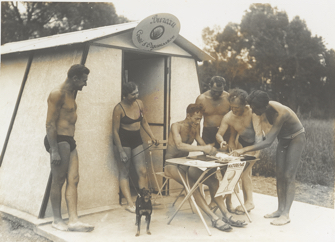
An undated postcard showing nature lovers on the Île du Platais. © Coll. David Lorenté
Platais, located not far from Paris and once home to Émile Zola? Among the few structures scattered around the exhibition is a copy of one of the permanent tents that were lined up on Physiopolis, a sight that inspired Jean de Brushoff to invent Celesteville, Babar’s hometown, where “every elephant has a house.”
There is even a romantic aura around the Île Sequin, nearly every inch of which was for decades covered with the massive factory built
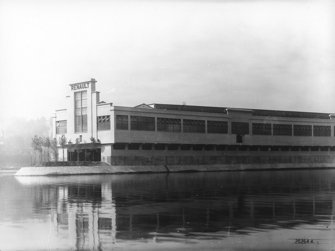
The Renault factory on the Île Seguin in September 1934. © Renault Communication-Droits réservés
by Renault in 1929, where some 30,000 workers made automobiles until 1992. Many of us still remember passing by the ghostly abandoned structures when driving west out of Paris.
In spite of efforts to save it, the factory, a monument to trade unionism, was torn down. The fate of the island then became a political hot potato. An ambitious cultural hub has finally been defined by starchitect Jean Nouvel, and a first building, the Cite Musicale (concert halls, recording studios, a music school and shops), a mushroom-shaped structure designed by Shigeru Ban and Jean de Gastines, is currently under construction. The site has a
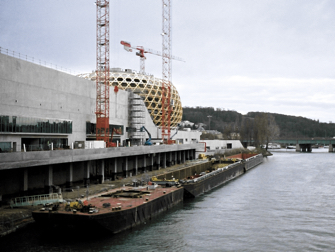
The Cité Musicale under construction on the Île Seguin. © Milena Charbit
temporary park and hosts various events while waiting for the major developments to start.
I also discovered that the Seine has its own Alcatraz. The Maison Centrale de Melun on the Île Saint Étienne, originally a prison for
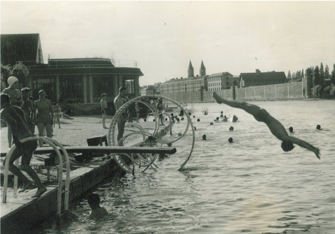
The prison on the île Saint-Étienne can be seen behind the swimmers on Melun’s artificial beach in this photo taken around 1950. © Archives Municipales de Melun
women, was expanded and fortified by Napoleon. Once reserved for the most dangerous prisoners, it is now used for short-term detainees.
These are just a few of the island stories. My first impression of this endlessly fascinating exhibition as intimidatingly text-y was mistaken. I recommend not only visiting it, but also buying the book as a guide to these mostly forgotten islands in the stream.
Pavillon de l’Arsenal: 21, boulevard Morland, 75004 Paris. Métro: Sully Morland. Tel.: 01 42 76 33 97. Open Tuesday-Saturday, 10:30am-6:30pm; Sunday, 11am-7pm. Admission: free. Through October 2, 2016. www.pavillon-arsenal.com
Reader reaction: Click here to respond to this article (your response may be published on this page and is subject to editing).
More reviews of Paris art shows.
© 2016 Paris Update
Favorite